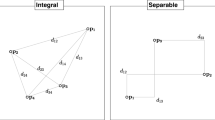Abstract
A multidimensional scaling analysis is presented for replicated layouts of pairwise choice responses. In most applications the replicates will represent individuals who respond to all pairs in some set of objects. The replicates and the objects are scaled in a joint space by means of an inner product model which assigns weights to each of the dimensions of the space. Least squares estimates of the replicates' and objects' coordinates, and of unscalability parameters, are obtained through a manipulation of the error sum of squares for fitting the model. The solution involves the reduction of a three-way least squares problem to two subproblems, one trivial and the other solvable by classical least squares matrix factorization. The analytic technique is illustrated with political preference data and is contrasted with multidimensional unfolding in the domain of preferential choice.
Similar content being viewed by others
References
Abelson, R. P. A technique and a model for multi-dimensional attitude scaling.Public Opinion Quarterly, 1954,18, 405–418.
Carroll, J. D. Individual differences and multidimensional scaling. Unpublished manuscript. Murray Hill, N. J.: Bell Telephone Laboratories, 1969.
Coombs, C. H.A theory of data. New York: Wiley, 1964.
Coombs, C. H., & Huang, L. C. A portfolio theory of risk preference. Michigan Mathematical Psychology Program Technical Report No. MMPP 68-5. Ann Arbor, Mich.: University of Michigan, 1968.
Coombs, C. H., & Kao, R. C. On a connection between factor analysis and multidimensional unfolding.Psychometrika, 1960,25, 219–231.
Eckart, C., & Young, G. The approximation of one matrix by another of lower rank.Psychometrika, 1936,1, 211–218.
Householder, A. S., & Young, G. Matrix approximation and latent roots.American Mathematical Monthly, 1938,45, 165–171.
Keller, J. B. Factorization of matrices by least-squares.Biometrika, 1962,49, 239–242.
Kruskal, J. B., & Carroll, J. D. Geometrical models and badness-of-fit functions. In P. R. Krishnaiah (Ed.),Multivariate analysis II. New York: Academic Press, 1969. Pp. 639–670.
Lingoes, J. C. An IBM-7090 program for Guttman-Lingoes smallest space analysis—RII.Behavioral Science, 1966,11, 322.
Messick, S. Dimensions of social desirability.Journal of Consulting Psychology, 1960,24, 279–287.
Morris, C., & Jones, L. V. Value scales and dimensions.Journal of Abnormal and Social Psychology, 1955,51, 523–535.
Ross, J., & Cliff, N. A generalization of the interpoint distance model.Psychometrika, 1964,29, 167–176.
Schönemann, P. H. On metric multidimensional unfolding. Research Bulletin. Princeton, N. J.: Educational Testing Service, in preparation.
Slater, P. The analysis of personal preferences.The British Journal of Statistical Psychology, 1960,13, 119–135.
Torgerson, W. S.Theory and methods of scaling. New York: Wiley, 1958.
Tucker, L. R. Intra-individual and inter-individual multidimensionality. In H. Gulliksen & S. Messick (Eds.),Psychological scaling: Theory and applications. New York: Wiley, 1960. Pp. 155–167.
Tucker, L. R. Comments on “Confounding of sources of variation in factor-analytic techniques.”Psychological Bulletin, 1968,70, 345–354.
Whittle, P. On principal components and least square methods of factor analysis.Skandinavisk Aktuarietidskrift, 1952,35, 223–239.
Young, F. W., & Torgerson, W. S. TORSCA, a Fortran IV program for Shepard-Kruskal multidimensional scaling analysis.Behavioral Science, 1967,12, 498.
Author information
Authors and Affiliations
Additional information
The present work was initiated at Oregon Research Institute under National Institute of Mental Health Grant MH 12972. It was reformulated and completed while the first author was a Visiting Research Fellow at Educational Testing Service.
Presently at the Department of Mathematics, University of Toronto.
Rights and permissions
About this article
Cite this article
Bechtel, G.G., Tucker, L.R. & Chang, WC. A scalar product model for the multidimensional scaling of choice. Psychometrika 36, 369–388 (1971). https://doi.org/10.1007/BF02291364
Received:
Revised:
Issue Date:
DOI: https://doi.org/10.1007/BF02291364




